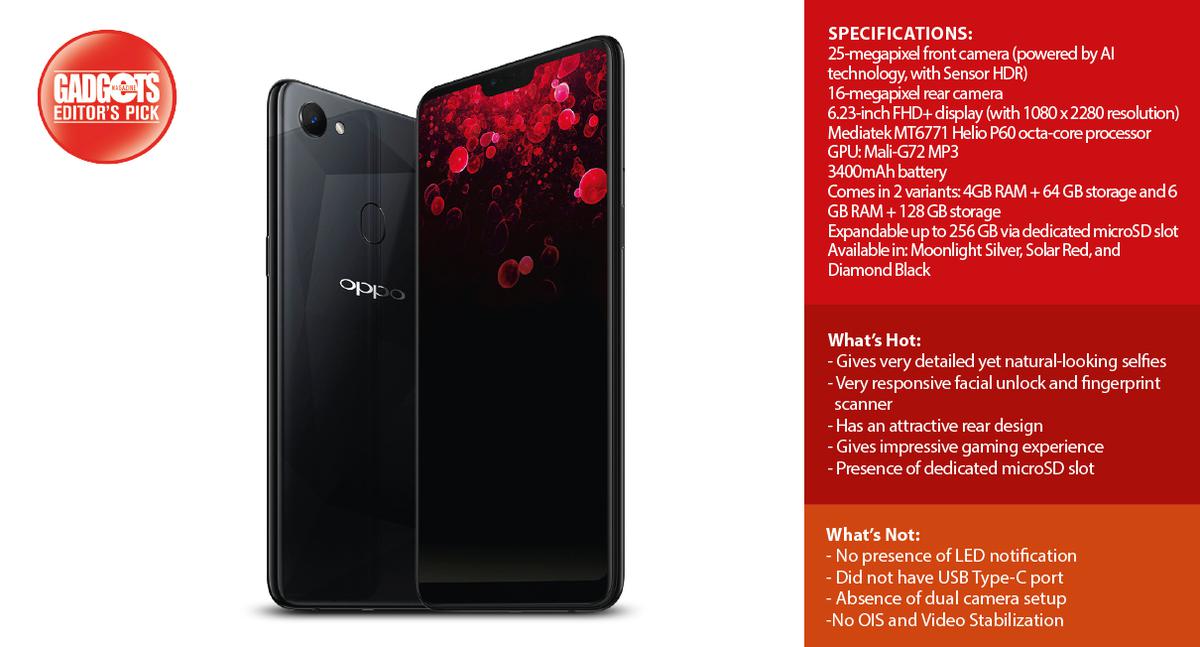Smartphone innovation has moved forward by leaps and bounds over the years, and new technologies introduced in today’s flagship devices only signify even more exciting things in the future. One brand that constantly brings cutting-edge devices to the market is Sony. We recently had the opportunity to put one of its premium flagship devices, XZ2, through its paces. Here’s how it went.
Design: 4.5/5
Let’s start with the basics. One thing that you’ll notice with the F7 is its stunning 6.23-inch full- screen display that gives an astonishing 89.09 percent screen-to-body ratio. It’s also protected by Corning Gorilla Glass 5 and has thin side bezels. The top notch 25-megapixel AI front camera, earpiece, and sensor are housed in the tiny top notch. Don’t expect an LED indicator though. The power button is located on the left side, while the volume rocker is on the opposite edge. The speakers, 3.5 mm audio jack, and main microphone are located at the bottom part. Sad to say, Oppo settled only for a micro-USB port instead of Type-C for this device.
When flipped, the compact and handy phone has a sexy, gorgeous geometrical design. Also, you can see the 16-megapixel rear camera and its fingerprint scanner. You can easily grip the device with just one hand, which is surprising given its 7.8mm thickness. With an acrylic finish yet solid body, the F7 is surely an eye catcher.
Hardware: 4/5
So what makes F7 different from its predecessor, the F5? Hardware-wise, the latter sports a Mediatek Helio P23 chipset while the former has a more advanced Helio P60 processor clocked at 2.0 GHz. This means faster image processing and seamless multitasking for users who are fond of mobile games and social media apps. In terms of storage space, the F7 has two 64 GB and 128 GB variants, both of which are partnered with either 4 GB or 6GB of RAM respectively. To make it more enticing, Oppo debuted the said phone as their first unit to run with ColorOS 5.0 based on Android Oreo. Battery capacity gets also an increase from 3200 to 3400 mAh. It also added gyroscope in its hardware to level up mobile gaming experience, most especially if you’re a fan of PUBG or ROS.
From 20-megapixels, the latest mid-ranger model flaunts a 25-megapixel AI front camera that captures the real you. Its 16-megapixel rear camera does not disappoint either. Aside from adapting the same AI beautification technology from its sister model, the latest addition to the F-Series also adds Sensor HDR for taking sensational selfies, and AI Scene Recognition that lets you take stunning scenes and objects in various conditions.
User Experience: 4/5
It felt like I was receiving a toy for Christmas as I unboxed the unit. Thanks to its fancy geometrical design, the device looks sleek and elegant. F7’s main selling point is its selfie camera, and oh boy it was the bomb. Its AI beautification has been greatly improved, as well as its depth of field and super vivid mode, which gives you more freedom in experimenting your photos. The 16-megapixel main camera is great as well. I used it to capture photos and videos from Ben & Ben’s free concert, in a low-light setting, and surprisingly it produced decent results. Pictures produced less noise despite of zooming it up to 4x, and the same goes to video clips.
If you’re a gamer who loves to record your gameplay, then this phone is for you. A screen recording feature was pre-installed in the device, which allows you to save your action-packed gaming experiences and share it online. Game acceleration, as the name suggests, gives boost in terms of graphics, optimizes the phone’s system, and restricts network access of background apps. The Assistive Ball, with the Gesture and Motion options, helped me navigating the whole device in just one hand. I also have to commend its 3400 mAh battery. Believe it or not, the F7 endured my heavy-duty usage of a data connection and PUBG, plus doing a 4 minute live video of the concert. I just noticed that it easily heats up when connected to mobile data than to Wi-Fi.
Value: 4/5
Let’s cut to the chase. Oppo has once again impressed us by giving a mid-ranger unit that showcases some flagship-like features. For one, it upgraded the chipset so that it can accommodate its AI features and its up-to-date OS of Android Oreo. It might not have the dual-camera setup and fast-charging capability that most frontliner phones have in the market, but the F7 gives almost the same results. Oh, and let’s not forget about the top notch that provides a larger screen.
Bottomline:
It’s a flagship phone disguised in a mid-ranger price.
Also published in GADGETS MAGAZINE June 2018 Issue.
Reviewed by Jewel Sta. Ana
